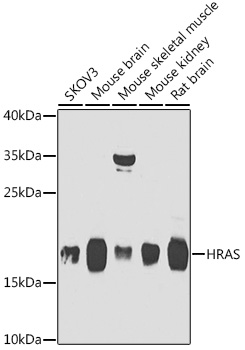H-Ras antibody
GTX116041
ApplicationsImmunoFluorescence, ImmunoPrecipitation, Western Blot, ImmunoCytoChemistry, ImmunoHistoChemistry, ImmunoHistoChemistry Paraffin
Product group Antibodies
ReactivityHuman, Mouse, Rat
TargetHRAS
Overview
- SupplierGeneTex
- Product NameH-Ras antibody
- Delivery Days Customer9
- Application Supplier NoteWB: 1:500-1:10000. ICC/IF: 1:100-1:1000. IHC-P: 1:100-1:1000. *Optimal dilutions/concentrations should be determined by the researcher.Not tested in other applications.
- ApplicationsImmunoFluorescence, ImmunoPrecipitation, Western Blot, ImmunoCytoChemistry, ImmunoHistoChemistry, ImmunoHistoChemistry Paraffin
- CertificationResearch Use Only
- ClonalityPolyclonal
- Concentration1.87 mg/ml
- ConjugateUnconjugated
- Gene ID3265
- Target nameHRAS
- Target descriptionHRas proto-oncogene, GTPase
- Target synonymsC-BAS/HAS, C-H-RAS, C-HA-RAS1, CTLO, H-RASIDX, HAMSV, HRAS1, RASH1, p21ras, GTPase HRas, GTP- and GDP-binding peptide B, Ha-Ras1 proto-oncoprotein, Harvey rat sarcoma viral oncogene homolog, Harvey rat sarcoma viral oncoprotein, Ras family small GTP binding protein H-Ras, c-has/bas p21 protein, p19 H-RasIDX protein, transformation gene: oncogene HAMSV, transforming protein p21, v-Ha-ras Harvey rat sarcoma viral oncogene homolog
- HostRabbit
- IsotypeIgG
- Protein IDP01112
- Protein NameGTPase HRas
- Scientific DescriptionThis gene belongs to the Ras oncogene family, whose members are related to the transforming genes of mammalian sarcoma retroviruses. The products encoded by these genes function in signal transduction pathways. These proteins can bind GTP and GDP, and they have intrinsic GTPase activity. This protein undergoes a continuous cycle of de- and re-palmitoylation, which regulates its rapid exchange between the plasma membrane and the Golgi apparatus. Mutations in this gene cause Costello syndrome, a disease characterized by increased growth at the prenatal stage, growth deficiency at the postnatal stage, predisposition to tumor formation, mental retardation, skin and musculoskeletal abnormalities, distinctive facial appearance and cardiovascular abnormalities. Defects in this gene are implicated in a variety of cancers, including bladder cancer, follicular thyroid cancer, and oral squamous cell carcinoma. Multiple transcript variants, which encode different isoforms, have been identified for this gene. [provided by RefSeq]
- ReactivityHuman, Mouse, Rat
- Storage Instruction-20°C or -80°C,2°C to 8°C
- UNSPSC12352203
References
- Catalano A, Adlesic M, Kaltenbacher T, et al. Sensitivity and Resistance of Oncogenic RAS-Driven Tumors to Dual MEK and ERK Inhibition. Cancers (Basel). 2021,13(8). doi: 10.3390/cancers13081852Read this paper
- Hu W, Liu Z, Salato V, et al. NOGOB receptor-mediated RAS signaling pathway is a target for suppressing proliferating hemangioma. JCI Insight. 2021,6(3):pii: 142299. doi: 10.1172/jci.insight.142299.Read this paper
- Wu HT, Liu YE, Hsu KW, et al. MLL3 Induced by Luteolin Causes Apoptosis in Tamoxifen-Resistant Breast Cancer Cells through H3K4 Monomethylation and Suppression of the PI3K/AKT/mTOR Pathway. Am J Chin Med. 2020,48(5):1221-1241. doi: 10.1142/S0192415X20500603Read this paper
- Gao P, Wang X, Jin Y, et al. Nogo-B receptor increases the resistance to tamoxifen in estrogen receptor-positive breast cancer cells. Breast Cancer Res. 2018,20(1):112. doi: 10.1186/s13058-018-1028-5Read this paper
- Sugita S, Enokida H, Yoshino H, et al. HRAS as a potential therapeutic target of salirasib RAS inhibitor in bladder cancer. Int J Oncol. 2018,53(2):725-736. doi: 10.3892/ijo.2018.4435Read this paper
- Brandt LP, Albers J, Hejhal T, et al. Mouse genetic background influences whether Hras(G12V) expression plus Cdkn2a knockdown causes angiosarcoma or undifferentiated pleomorphic sarcoma. Oncotarget. 2018,9(28):19753-19766. doi: 10.18632/oncotarget.24831Read this paper
- Sarin N, Engel F, Rothweiler F, et al. Key Players of Cisplatin Resistance: Towards a Systems Pharmacology Approach. Int J Mol Sci. 2018,19(3). doi: 10.3390/ijms19030767Read this paper
- Brandt LP, Albers J, Hejhal T, et al. Oncogenic HrasG12V expression plus knockdown of Cdkn2a using ecotropic lentiviral vectors induces high-grade endometrial stromal sarcoma. PLoS One. 2017,12(10):e0186102. doi: 10.1371/journal.pone.0186102Read this paper
- Tsuboi M, Taniuchi K, Shimizu T, et al. The transcription factor HOXB7 regulates ERK kinase activity and thereby stimulates the motility and invasiveness of pancreatic cancer cells. J Biol Chem. 2017,292(43):17681-17702. doi: 10.1074/jbc.M116.772780Read this paper




![WB analysis of various samples using GTX80140 H-Ras antibody [H-RAS-03]. Lane 1 : HeLa Lane 2 : K567 Lane 3 : Raji](https://www.genetex.com/upload/website/prouct_img/normal/GTX80140/GTX80140_20191028_WB_1_w_23061322_427.webp)
